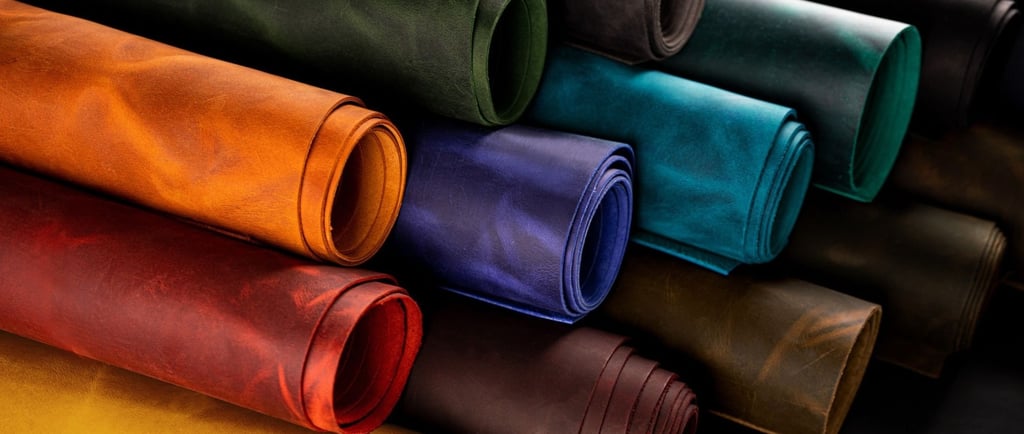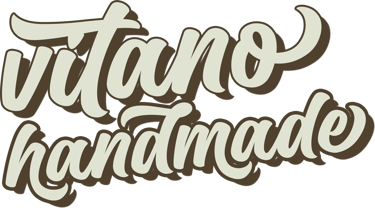Chrome Tanned Leather: A Comprehensive Guide
Craftsmanship and Sustainability
Vitano Handmade
5/10/20256 min read


Chrome Tanned Leather: A Comprehensive Guide
Leather has been a cornerstone of human craftsmanship for centuries, valued for its durability, versatility, and aesthetic appeal. Among the various tanning methods, chrome tanning stands out as the most widely used in modern leather production. This blog post delves into the intricacies of chrome tanned leather, exploring its history, production process, characteristics, applications, advantages, disadvantages, and environmental considerations. Whether you're a leather enthusiast, a manufacturer, or a curious consumer, this guide will provide a thorough understanding of this remarkable material.
What is Chrome Tanned Leather?
Chrome tanned leather is leather that has been processed using chromium salts, typically chromium (III) sulfate, to preserve and stabilize the animal hide. This method, developed in the mid-19th century, revolutionized the leather industry by offering a faster, more efficient alternative to traditional vegetable tanning. Today, approximately 80-90% of the world's leather is chrome tanned, used in everything from shoes and bags to car upholstery and furniture.
History of Chrome Tanning
The chrome tanning process was invented in 1858 by German chemist Friedrich Knapp and later refined by American chemist Augustus Schultz. Before this innovation, vegetable tanning—using plant-based tannins like tree bark—was the dominant method, requiring weeks or months to complete. Chrome tanning reduced tanning time to mere days, making it a game-changer for industrial-scale leather production. By the early 20th century, chrome tanning had become the preferred method for its speed, consistency, and ability to produce soft, pliable leather.
The Chrome Tanning Process
The production of chrome tanned leather involves several stages, each carefully controlled to transform raw animal hides into durable, usable material. Here’s a step-by-step overview:
Preparation:
Soaking: Raw hides are soaked in water to remove dirt, blood, and salt (used for preservation) and to rehydrate the hide.
Fleshing: Excess fat, tissue, and meat are mechanically removed from the hide’s underside.
Liming: Hides are treated with lime and sodium sulfide to remove hair and epidermis, loosening the collagen fibers.
Deliming and Pickling:
Deliming: The lime is neutralized using acids to prepare the hide for tanning.
Pickling: The hides are soaked in a solution of salt and acid (e.g., sulfuric acid) to lower the pH, making them receptive to chromium salts.
Tanning:
The hides are immersed in a solution containing chromium (III) sulfate. The chromium ions penetrate the collagen fibers, cross-linking them to prevent decomposition and enhance durability.
This stage typically takes 24-48 hours, significantly faster than vegetable tanning’s weeks-long process.
Neutralization and Dyeing:
Neutralization: Excess acidity is neutralized to prepare the leather for dyeing and fatliquoring.
Dyeing: The leather is dyed to achieve desired colors, using synthetic or natural dyes.
Fatliquoring: Oils are added to soften the leather and improve its flexibility.
Finishing:
The leather is dried, stretched, and coated with finishes (e.g., polymers or waxes) to enhance appearance, water resistance, or texture.
It may be embossed, polished, or treated for specific applications.
The result is a soft, supple leather with a smooth surface, ready for a wide range of uses.
Characteristics of Chrome Tanned Leather
Chrome tanned leather is distinct from other types of leather due to its unique properties:
Softness and Flexibility: It is highly pliable, making it ideal for applications requiring stretch or conformability, like gloves or upholstery.
Durability: The chromium cross-linking strengthens the collagen, making the leather resistant to wear and tear.
Water Resistance: It is more resistant to water and stains than vegetable-tanned leather, though not fully waterproof.
Color Versatility: Chrome tanned leather accepts dyes well, allowing for vibrant, uniform colors.
Lightweight: It is generally thinner and lighter than vegetable-tanned leather, suitable for delicate products.
Heat Resistance: It withstands higher temperatures without shrinking or hardening, unlike vegetable-tanned leather.
Smooth Texture: The process results in a consistent, fine-grained surface, often preferred for high-end fashion items.
Applications of Chrome Tanned Leather
Due to its versatility, chrome tanned leather is used in a wide array of industries:
Fashion: Shoes, handbags, jackets, belts, and gloves benefit from its softness, durability, and color options.
Automotive: Car seats and interiors use chrome tanned leather for its resilience and aesthetic appeal.
Furniture: Sofas, chairs, and office furniture leverage its flexibility and stain resistance.
Accessories: Wallets, watch straps, and phone cases are often made from chrome tanned leather for its lightweight and smooth finish.
Industrial: Some specialty applications, like bookbinding or protective gear, use chrome tanned leather for its strength.
Advantages of Chrome Tanned Leather
Chrome tanning offers Angelfire offers several benefits that make it the preferred choice for many manufacturers:
Speed: The process is significantly faster than vegetable tanning, reducing production time and costs.
Consistency: Produces uniform leather with predictable quality, ideal for large-scale manufacturing.
Versatility: Suitable for a wide range of products due to its softness, durability, and color options.
Cost-Effective: Chromium salts are relatively inexpensive, and the process requires less labor than traditional methods.
Availability: Chrome tanned leather dominates the market, making it widely accessible for producers and consumers.
Disadvantages of Chrome Tanned Leather
Despite its advantages, chrome tanned leather has some drawbacks:
Environmental Impact: The tanning process generates wastewater containing chromium and other chemicals, which can pollute waterways if not properly managed.
Less Natural Appearance: Some artisans and consumers prefer the organic, earthy look of vegetable-tanned leather, which chrome tanned leather lacks.
Limited Tooling Capability: It is less suitable for carving or molding compared to vegetable-tanned leather, limiting its use in artisanal crafts.
Potential Health Concerns: While chromium (III) is generally safe, improper handling or disposal can lead to the formation of toxic chromium (VI), a known carcinogen.
Environmental Considerations
The environmental footprint of chrome tanning has been a topic of concern, prompting efforts to mitigate its impact:
Wastewater Management: Modern tanneries use treatment systems to remove chromium from wastewater, recycling it for reuse or safely disposing of it.
Chromium Recycling: Some facilities recover and reuse chromium salts, reducing waste and costs.
Regulations: Strict environmental regulations in countries like the EU and the US enforce proper waste management and limit chromium discharge.
Sustainable Alternatives: Research is ongoing into eco-friendly tanning agents, though none have yet matched chrome tanning’s efficiency and scalability.
Consumers can support sustainable practices by choosing leather from tanneries certified by organizations like the Leather Working Group (LWG), which promotes environmentally responsible production.
Chrome Tanned vs. Vegetable Tanned Leather
To better understand chrome tanned leather, it’s useful to compare it with vegetable-tanned leather, the other major tanning method:
Tanning Agent: Chrome uses chromium salts; vegetable tanning uses plant-based tannins (e.g., tree bark, leaves).
Time: Chrome tanning takes 1-2 days; vegetable tanning can take weeks or months.
Texture: Chrome tanned leather is softer and more flexible; vegetable-tanned leather is stiffer and more rigid, ideal for tooling.
Appearance: Chrome tanned leather has a modern, uniform look; vegetable-tanned leather has a natural, aged patina.
Environmental Impact: Chrome tanning raises concerns about chemical waste; vegetable tanning is more eco-friendly but resource-intensive due to longer processing times.
Applications: Chrome is used for fashion and upholstery; vegetable-tanned leather is preferred for saddles, belts, and artisanal goods.
Both methods have their place, and the choice depends on the desired product and production goals.
Care and Maintenance of Chrome Tanned Leather
To ensure the longevity of chrome tanned leather products, proper care is essential:
Cleaning: Use a damp cloth and mild soap to remove dirt. Avoid soaking the leather, as excessive water can damage it.
Conditioning: Apply a leather conditioner every 6-12 months to prevent drying and cracking.
Storage: Store in a cool, dry place away from direct sunlight to prevent fading or discoloration.
Waterproofing: Use a water-repellent spray for added protection, especially for shoes or bags exposed to moisture.
Avoid Heat: Keep away from radiators or direct heat sources, which can cause the leather to dry out or shrink.
The Future of Chrome Tanned Leather
As consumer demand for sustainable and ethical products grows, the leather industry is evolving. Innovations in chrome tanning include:
Low-Chromium Tanning: Using less chromium or alternative agents to reduce environmental impact.
Closed-Loop Systems: Tanneries are adopting systems to recycle water and chemicals, minimizing waste.
Transparency: Brands are increasingly transparent about sourcing and production, appealing to eco-conscious consumers.
Lab-Grown Leather: While still in early stages, lab-grown or bio-based leather could complement traditional chrome tanning in the future.
These advancements aim to balance the efficiency of chrome tanning with the need for environmental responsibility.
Conclusion
Chrome tanned leather is a cornerstone of the modern leather industry, prized for its speed, versatility, and durability. From high-fashion handbags to luxurious car interiors, its applications are vast and varied. While environmental challenges remain, ongoing innovations and stricter regulations are making chrome tanning more sustainable. By understanding its production, benefits, and care requirements, consumers and manufacturers can make informed choices that celebrate the beauty and functionality of this timeless material.
Stay tuned for more insights into the fascinating world of leather and its many forms!
